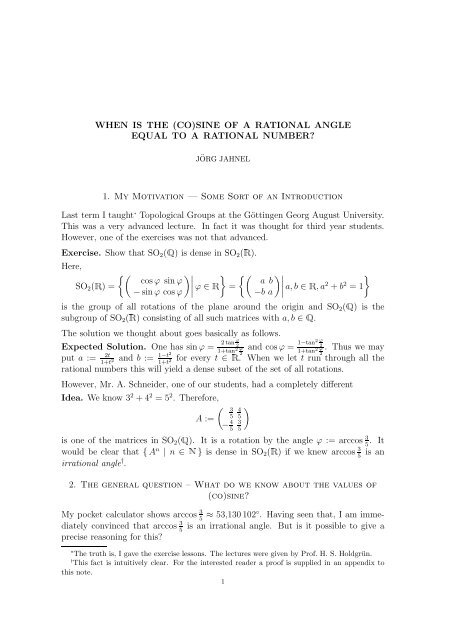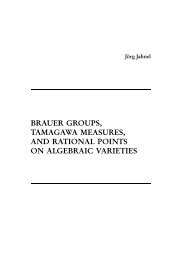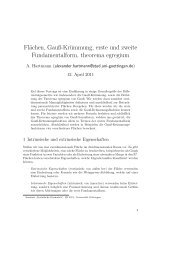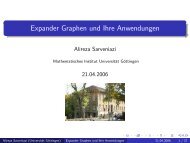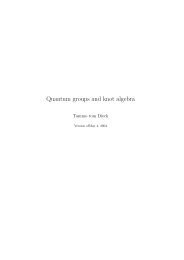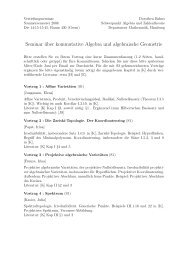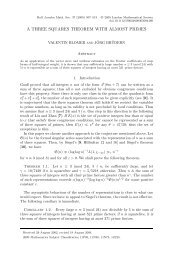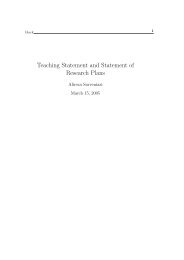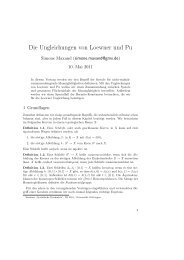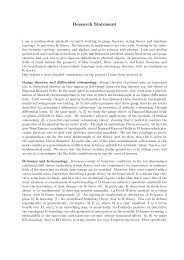SINE OF A RATIONAL ANGLE EQUAL TO A RATIONAL NUMBER?
SINE OF A RATIONAL ANGLE EQUAL TO A RATIONAL NUMBER?
SINE OF A RATIONAL ANGLE EQUAL TO A RATIONAL NUMBER?
Create successful ePaper yourself
Turn your PDF publications into a flip-book with our unique Google optimized e-Paper software.
WHEN IS THE (CO)<strong>SINE</strong> <strong>OF</strong> A <strong>RATIONAL</strong> <strong>ANGLE</strong><br />
<strong>EQUAL</strong> <strong>TO</strong> A <strong>RATIONAL</strong> <strong>NUMBER</strong>?<br />
JÖRG JAHNEL<br />
1. My Motivation — Some Sort of an Introduction<br />
Last term I taught ∗ Topological Groups at the Göttingen Georg August University.<br />
This was a very advanced lecture. In fact it was thought for third year students.<br />
However, one of the exercises was not that advanced.<br />
Exercise. Show that SO 2 (É) is dense in SO 2 (Ê).<br />
Here,<br />
SO 2 (Ê) =<br />
{( )∣<br />
cosϕ sin ϕ ∣∣∣<br />
ϕ ∈Ê}<br />
=<br />
− sin ϕ cos ϕ<br />
{( )∣<br />
a b ∣∣∣<br />
a, b ∈Ê, a<br />
−b a<br />
2 + b 2 = 1}<br />
is the group of all rotations of the plane around the origin and SO 2 (É) is the<br />
subgroup of SO 2 (Ê) consisting of all such matrices with a, b ∈É.<br />
The solution we thought about goes basically as follows.<br />
Expected Solution. One has sin ϕ = 2tan ϕ 2<br />
1+tan 2 ϕ and cosϕ = 1−tan2 ϕ 2<br />
1+tan 2<br />
2 ϕ . Thus we may<br />
2<br />
put a := 2t and b := 1−t2 for every t ∈Ê. When we let t run through all the<br />
1+t 2 1+t 2<br />
rational numbers this will yield a dense subset of the set of all rotations.<br />
However, Mr. A. Schneider, one of our students, had a completely different<br />
Idea. We know 3 2 + 4 2 = 5 2 . Therefore,<br />
4<br />
5<br />
− 4 3<br />
5 5<br />
A :=<br />
( 3<br />
5<br />
is one of the matrices in SO 2 (É). It is a rotation by the angle ϕ := arccos 3. It 5<br />
would be clear that { A n | n ∈Æ} is dense in SO 2 (Ê) if we knew arccos 3 is an<br />
5<br />
irrational angle † .<br />
2. The general question – What do we know about the values of<br />
(co)sine?<br />
My pocket calculator shows arccos 3 ≈ 53,130 5 102◦ . Having seen that, I am immediately<br />
convinced that arccos 3 is an irrational angle. But is it possible to give a<br />
5<br />
precise reasoning for this?<br />
∗ The truth is, I gave the exercise lessons. The lectures were given by Prof. H. S. Holdgrün.<br />
†<br />
This fact is intuitively clear. For the interested reader a proof is supplied in an appendix to<br />
this note.<br />
1<br />
)
2 JÖRG JAHNEL<br />
Questions. Let α = m n · 360◦ be a rational angle.<br />
i) When is cos α equal to a rational number?<br />
ii) When is cos α an algebraic number?<br />
One might want to make the second question more precise.<br />
ii.a) What are the rational angles whose cosines are algebraic numbers of low degree?<br />
For instance, when is cosα equal to a quadratic irrationality? When is it a cubic<br />
irrationality?<br />
3. Rational Numbers<br />
We know that −1, − 1, 0, 1 , and 1 are special values of the trigonometric functions<br />
2 2<br />
at rational angles. Indeed, cos 180 ◦ = −1, cos 120 ◦ = − 1, cos 2 90◦ = 0, cos 60 ◦ = 1,<br />
2<br />
and cos 0 ◦ = 1. It turns out that these are the only rational numbers with this<br />
property. Even more, there is an elementary argument for this based on the famous<br />
addition formula for cosine.<br />
Theorem. Let α be a rational angle. Assume that cosα is a rational number. Then<br />
cos α ∈ {−1, − 1 2 , 0, 1 2 , 1}.<br />
Proof. The addition formula for cosine immediately implies cos 2α = 2 cos 2 α − 1.<br />
For ease of computation we will multiply both sides by 2 and work with<br />
2 cos 2α = (2 cosα) 2 − 2.<br />
Assume 2 cosα = a b is a rational number. We may choose a, b ∈, b ≠ 0 such that<br />
they do not have any common factors. The formula above shows<br />
2 cos2α = a2<br />
b − 2 = a2 − 2b 2<br />
.<br />
2 b 2<br />
We claim that a 2 − 2b 2 and b 2 again have no common factors. Indeed, assume p<br />
would be a prime number dividing both. Then, p|b 2 =⇒ p|b and p|(a 2 −2b 2 ) =⇒ p|a.<br />
This is a contradiction.<br />
Therefore, if b ≠ ±1 then in 2 cosα, 2 cos 2α, 2 cos 4α, 2 cos8α, 2 cos 16α, . . . the<br />
denominators get bigger and bigger and there is nothing we can do against that.<br />
On the other hand, α = m n · 360◦ is assumed to be a rational angle. cos is periodic<br />
with period 360 ◦ . Hence, the sequence (2 cos2 k α) k∈Æmay admit at most n different<br />
values. Thus, it will run into a cycle. This contradicts the observation above that<br />
its denominators necessarily tend to infinity.<br />
By consequence, the only way out is that b = ±1. Only −1, − 1, 0, 1 and 1 may be<br />
2 2<br />
rational values of cos at rational angles.<br />
□<br />
Of course, the same result is true for sine.<br />
sin α = cos(90 ◦ − α) into account.<br />
One just has to take the formula<br />
The Theorem shows, in particular, that Mr. Schneider is right. arccos 3 is indeed<br />
5<br />
an irrational angle.
WHEN IS THE (CO)<strong>SINE</strong> <strong>OF</strong> A <strong>RATIONAL</strong> <strong>ANGLE</strong> <strong>EQUAL</strong> <strong>TO</strong> A <strong>RATIONAL</strong> <strong>NUMBER</strong>? 3<br />
4. Algebraic Numbers<br />
There is the following generalization of the Theorem above from rational to algebraic<br />
numbers.<br />
Theorem. Let α be a rational angle. Then<br />
i) cosα is automatically an algebraic number. Even more, 2 cosα is an algebraic<br />
integer.<br />
ii) All the conjugates of 2 cosα are of absolute value ≤ 2.<br />
Proof. i) Let α = m n · 360◦ . We use the well-known formula of Moivre which is<br />
nothing but the result of an iterated application of the addition formula.<br />
1 = cosnα<br />
= cos n α −<br />
( ( )<br />
n n<br />
cos<br />
2)<br />
n−2 α sin 2 α + · · · + (−1) k cos n−2k α sin 2k α + · · ·<br />
2k<br />
⌊<br />
∑<br />
n 2 ⌋ ( ) n<br />
= (−1) k cos n−2k α (1 − cos 2 α) k<br />
2k<br />
k=0<br />
⌊<br />
∑<br />
n 2 ⌋ ( ) n<br />
= (−1) k cos n−2k α ·<br />
2k<br />
=<br />
k=0<br />
n∑<br />
m=0<br />
n−m even<br />
⌊ n 2 ⌋ ∑<br />
k= n−m<br />
2<br />
k∑<br />
l=0<br />
( )(<br />
(−1) n−m n k<br />
2<br />
n−m<br />
2k<br />
2<br />
( ) k<br />
(−1) l cos 2l α<br />
k − l<br />
)<br />
cos m α.<br />
The coefficient of cos n α is ∑ ⌊ n 2 ⌋<br />
k=0<br />
( n<br />
2k)<br />
= 2<br />
n−1 ≠ 0. We found a polynomial P ∈[X]<br />
of degree n such that cosα is a solution of P(X) − 1 = 0. In particular, cosα is an<br />
algebraic number of degree ≤ n.<br />
Algebraic number theory shows that the ring of algebraic integers in an algebraic<br />
number field is a Dedekind ring, i.e. there is a unique decomposition into prime<br />
ideals. The argument from the proof above may be carried over.<br />
If (2 cosα) = p e 1<br />
1 · · · · · per r is the decomposition into prime ideals and e i < 0 then<br />
(2 cos 2α) = p 2e 1<br />
i · (powers of other primes). Indeed, 2 cos2α = (2 cosα) 2 − 2 and<br />
2 contains p i to a non-negative exponent.<br />
In the sequence (2 cos 2 k α) k∈Æthe exponent of p i will tend to −∞. As that sequence<br />
runs into a cycle, this is a contradiction.<br />
By consequence, e 1 , . . ., e r ≥ 0 and 2 cosα is an algebraic integer.<br />
ii) We claim, every zero of the polynomial P(X) − 1 obtained in the proof of i) is<br />
real and in [−1, 1]. Unfortunately, the obvious idea to provide n zeroes explicitly<br />
fails due to the fact that there may exist multiple zeroes.<br />
That is why instead of P(X) − 1 we first consider P(X) − cosδ for some real<br />
δ ≠ 0. This means, in the calculation above we start with cosδ = cos nα<br />
and no more with 1 = cos nα. There are n obvious solutions, namely
4 JÖRG JAHNEL<br />
cos δ δ+360◦<br />
, cos , . . .,cos δ+(n−2)·360◦ , and δ+(n−1)·360◦ . For δ in a sufficiently small<br />
n n<br />
n<br />
n<br />
neighbourhood of zero these values are different from each other. P(X) − cosδ is<br />
the product of n linear factors as follows,<br />
P(X) − cos δ = 2 n−1 (X − cos δ n<br />
Going over to the limit for δ → 0 gives our claim.<br />
δ+360◦<br />
)(X − cos ) · · · · · (X − cos δ+(n−1)·360◦ ).<br />
n<br />
n<br />
It is not hard to see that for every n ∈Æand every A ∈Êthere are only finitely<br />
many algebraic integers of degree n all the conjugates of which are of absolute<br />
value ≤ A.<br />
□<br />
5. Degrees two and three<br />
It should be of interest to find all the algebraic numbers of low degree which occur<br />
as special values of (co)sine at rational angles.<br />
Observation (Quadratic Irrationalities). i) Let x be a quadratic integer such that<br />
|x| < 2 and |x| < 2. Then, x = ± √ 2, x = ± √ 3, or x = ± 1 ± 1 2 2√<br />
5.<br />
√<br />
ii) Among the quadratic irrationalities, only ± 2√ 1 2, ±<br />
1<br />
2 3, and ±<br />
1<br />
± 1 4 4√<br />
5 may be<br />
values of cos at rational angles.<br />
Proof. Let x := a+b √ D where a, b ∈Éand D ∈Æis square-free. x is an algebraic<br />
integer for a, b ∈. For D ≡ 1 (mod 4) it is also an algebraic integer when a and b<br />
are both half-integers and a − b ∈. (Note e.g. that 1 2 ± 1 2√<br />
5 solve x 2 − x − 1 = 0.)<br />
Assume |a + b √ D| < 2 and |a − b √ D| < 2. Without restriction we may suppose<br />
a ≥ 0 and b > 0. If D ≢ 1 (mod 4) then √ D < 2 and D = 2, 3. If D ≡ 1 (mod 4)<br />
then 1 2 + 1 2√<br />
D < 2,<br />
√<br />
D < 3, and thus D = 5. □<br />
Indeed, one has the well-known formulae cos 45 ◦ = 1 2√<br />
2 and cos 30 ◦ = 1 2√<br />
3. Correspondingly,<br />
cos 135 ◦ = − 1 2√<br />
2 and cos 150 ◦ = − 1 2√<br />
3. Further, cos 36 ◦ = 1 4 + 1 4√<br />
5,<br />
cos 72 ◦ = − 1 4 + 1 4√<br />
5, cos 108 ◦ = 1 4 − 1 4√<br />
5, and cos 144 ◦ = − 1 4 − 1 4√<br />
5.<br />
The latter four values are closely related to the constructibility of the regular pentagon.<br />
So, virtually, they were known in ancient Greece. Nevertheless, a formula<br />
like sin 18 ◦ = cos 72 ◦ = − 1 4 + 1 4√<br />
5 does typically not show up in today’s school or<br />
Calculus books while the first four special values usually do.<br />
Cubic Irrationalities. We use the “méthode brutale”. If |α 1 |, |α 2 |, |α 3 | < 2 then the<br />
polynomial x 3 +ax 2 +bx+c = (x −α 1 )(x −α 2 )(x −α 3 ) fulfills |a| < 6, |b| < 12, and<br />
|c| < 8. All these polynomials may rapidly be tested by a computer algebra system.<br />
The computation shows there are exactly 26 cubic polynomials with integer coefficients<br />
and three real zeroes in (−2, 2). However, only four of them are irreducible.<br />
These are the following.<br />
i) x 3 − x 2 − 2x + 1,<br />
zeroes: 2 cos 1 7 180◦ , 2 cos 3 7 180◦ , 2 cos 5 7 180◦ ,
WHEN IS THE (CO)<strong>SINE</strong> <strong>OF</strong> A <strong>RATIONAL</strong> <strong>ANGLE</strong> <strong>EQUAL</strong> <strong>TO</strong> A <strong>RATIONAL</strong> <strong>NUMBER</strong>? 5<br />
ii) x 3 + x 2 − 2x − 1,<br />
zeroes: 2 cos 2 7 180◦ , 2 cos 4 7 180◦ , 2 cos 6 7 180◦ ,<br />
iii) x 3 − 3x + 1,<br />
zeroes: 2 cos40 ◦ , 2 cos80 ◦ , 2 cos 160 ◦ ,<br />
iv) x 3 − 3x − 1,<br />
zeroes: 2 cos20 ◦ , 2 cos100 ◦ , 2 cos140 ◦ .<br />
The zeroes found are indeed special values of (co)sine at rational angles. They are<br />
related to the regular 7-, 9-, (14-, and 18-)gons.<br />
6. An outlook to the case of arbitrary degree<br />
At this point it should be said that, as in real life, when someone is willing to invest<br />
more then she/he has the chance to earn more. For the story discussed above it<br />
turns out it is helpful to invest complex numbers and some abstract algebra.<br />
For example, one has 2 cosα = e αi + e −αi = e m n 2πi + e − m n 2πi = ζn m + ζ n<br />
−m showing<br />
immediately that 2 cosα is a sum of two roots of unity. In particular, it is an<br />
algebraic integer.<br />
It is also possible to answer the general question from the introduction for algebraic<br />
numbers of higher degree.<br />
Theorem. Let α = m n · 360◦ be a rational angle. Assume that m, n ∈, n ≠ 0 do<br />
not have any common factors. Then<br />
i) cosα is a rational number if and only if ϕ(n) ≤ 2, i.e. for n = 1, 2, 3, 4, and 6.<br />
ii) cosα is an algebraic number of degree d > 1 if and only if ϕ(n) = 2d.<br />
Here, ϕ means Euler’s ϕ-function.<br />
Proof. Note that ϕ(n) is always even except for ϕ(1) = ϕ(2) = 1.<br />
The well-known formula cosα = ζm n +ζn<br />
−m<br />
implies that ζ m 2 n solves the quadratic equation<br />
X 2 −2(cos α)X +1 = 0 overÉ(cos α). Further, ζn m generatesÉ(ζ n ) as m and n<br />
are relatively prime. Thus, [É(ζ n ) :É(cos α)] = 1 or 2.<br />
AsÉ(cosα) ⊆Êthat degree can be equal to 1 only if ζ n ∈Ê, i.e. only for n = 1, 2.<br />
Otherwise, [É(cosα) :É] = [É(ζ n):É]<br />
= ϕ(n) . □<br />
2 2<br />
It is now easily possible to list all quartic and quintic irrationalities that occur as<br />
special values of the trigonometric functions sin and cos.<br />
ϕ(n) = 8 happens for n = 15, 16, 20, 24, and 30. Hence, cosα is a quartic irrationality<br />
for α = 24 ◦ , 48 ◦ ;22 1 ◦ , 67 1 ◦ ;18 ◦ , 54 ◦ ;15 ◦ , 75 ◦ ;12 ◦ , and 84 ◦ . These are the only<br />
2 2<br />
rational angles with that property in the range from 0 ◦ to 90 ◦ .<br />
ϕ(n) = 10 happens only for n = 11 and n = 22. cos 1<br />
11 180◦ , . . . , cos 5 11 180◦ are<br />
quintic irrationalities. These are the only ones occurring as special values of cos at<br />
rational angles between 0 ◦ and 90 ◦ .
6 JÖRG JAHNEL<br />
Appendix<br />
Let us finally explain the correctness of the density argument from the introduction.<br />
Why do the multiples of an irrational angle fill the circle densely?<br />
Fact. Let ϕ be an irrational angle. Then { nϕ | n ∈Æ} is a dense subset of the set<br />
[0 ◦ , 360 ◦ ) of all angles. This means, for every ̺ ∈ [0 ◦ , 360 ◦ ) and every N ∈Æthere<br />
exists some n ∈Æsuch that |nϕ − ̺| < 360◦ . N<br />
Proof. Consider the N + 1 angles ϕ, 2ϕ, . . . , (N + 1)ϕ. As they are all irrational,<br />
each of them is located in one of the N segments (0 ◦ , 1 N 360◦ ), ( 1 N 360◦ , 2 N 360◦ ),<br />
. . . , ( N−2<br />
N 360◦ , N−1<br />
N 360◦ ), and ( N−1<br />
N 360◦ , 360 ◦ ). By Dirichlet’s box principle,<br />
there are two angles aϕ, bϕ (a < b) within the same box. It follows that<br />
0 ◦ < sϕ := (b − a)ϕ < 1 N 360◦ . Put M := ⌊ 360◦ ⌋. Clearly, M > N.<br />
sϕ<br />
Now, let ̺ ∈ (0 ◦ , 360 ◦ ) be an arbitrary angle. We put<br />
R := max { r ∈ {0, 1, . . . , M} | rsϕ ≤ ̺ }.<br />
Then Rsϕ ≤ ̺ < (R + 1)sϕ. which implies |̺ − (R + 1)sϕ| ≤ sϕ < 1 N 360◦ . As<br />
N ∈Æmay still be chosen freely we see that there are multiples of ϕ arbitrarily<br />
close to ̺.<br />
□<br />
References<br />
[1] Gradstein, I. S.; Ryshik, I. M.: Tables of series, products and integrals, Vol. 1, German and<br />
English dual language edition, Verlag Harri Deutsch, Thun 1982<br />
[2] Hardy, G. H.; Wright, E. M.: An introduction to the theory of numbers, Fifth edition, The<br />
Clarendon Press, Oxford University Press, New York 1979<br />
[3] Lang, S.: Algebraic number theory, Second edition, Graduate Texts in Mathematics 110,<br />
Springer-Verlag, New York 1994


